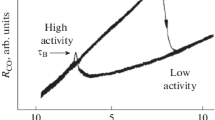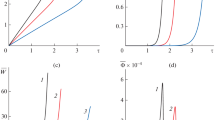Abstract
The kinetics of linear chemical reactions in an inhomogeneous medium is modeled as an evolutionary system characterized by a fractional derivative. The corresponding mathematical model depending on one nonlocal parameter \(0< \alpha <1\) is proposed. Reactions with one degree of freedom are analyzed. Solutions of the corresponding kinetic equations are shown to depend on the nonlocality parameter \(\alpha \). The concept of the critical moment of time is introduced, and the dependence of its value on the value of the relaxation coefficient is determined.


Similar content being viewed by others
References
R.D. Levine, Molecular Reaction Dynamics (Cambridge University Press, Cambridge, 2005)
H. Gutfreund, Kinetics for the Life Sciences: Receptors, Transmitters and Catalysts (Cambridge University Press, Cambridge, 1998)
A.N. Gorban, I.V. Karlin, Invariant Manifolds for Physical and Chemical Kinetics (Springer, Berlin, Heidelberg, 2010)
A.M. Zhabotinsky, Concentrated Auto-Oscillations (Nauka, Moscow, 1974, in Russian)
P. Érdi, J. Tóth, Mathematical Models of Chemical Reactions (Princeton University Press, Princeton, 1989)
A.N. Gorban, V.I. Bykov, G.S. Yablonsky, Story about Chemical Relaxation (Nauka, Novosibirsk, 1986, in Russian)
P. Miškinis, Math. Model. Anal. 15(2), 235 (2010)
F. Amblard, A.C. Maggs, B. Yurke, A.N. Pargellis, S. Leibler, Phys. Rev. Lett. 77, 4470 (1996)
J.-P. Bouchaud, A. Georges, J. Koplik, A. Provata, S. Redner, Phys. Rev. Lett. 64, 2503 (1990)
M. Barlow, E. Perkins, Prob. Theory Relat. Fields 79, 543 (1988)
M.T. Barlow, R.F. Bass, J. Funct. Anal. 175, 214 (2000)
S.G. Samko, A.A. Kilbas, O.I. Marichev, Fractional Integrals and Derivatives. Theory and Applications (Gordon and Breach, Yverdon, 1993)
I. Podlubny, Fractional Differential Equations (Academic Press, San Diego, 1999)
P. Miškinis, Nonlinear and nonlocal integrable models (Technika, Vilnius, 2003)
W.C. Bray, J. Am. Chem. Soc. 43(6), 1262 (1921)
B.P. Belousov, Collect. Abstr. Radiat. Med. 147, 145 (1959). (in Russian)
A.M. Zhabotinsky, Biofizika 9, 306 (1964). (in Russian)
J. Higgins, Ind. Eng. Chem. 59, 19 (1967)
R.M. Noyes, R.J. Field, E. Körös, J. Am. Chem. Soc. 94, 1394 (1972)
A.A. Andronov, A.A. Vitt, S.E. Khaikin, Theory of Oscillators (Dover Publications, New York, 1987)
W. Jost, Z. Phys. Chem. 105, 317 (1950)
J. Meixner, Phys. Blätter 16, 506 (1960)
A.A. Kilbas, H.M. Srivastava, J.J. Trujillo, Theory and Applications of Fractional Differential Equations (Elsevier, Amsterdam, Netherlands, 2006)
H.J. Haubold, A.M. Mathai, R.K. Saxena, Mittag-Leffler functions and their applications [http://arxiv.org/arxiv:0909.0230v2]
R. Csikja, J. Tóth, Enformatika. Int. J. Appl. Math. Comput. Sci. 4(2), 728 (2007)
P. Grindrod, Patterns and Waves: The Theory and Applications of Reaction-Diffusion Equations (Clarendon Press, Oxford, 1991)
Selected Papers of Norbert Wiener (MIT Press & SIAM, Cambridge, MA, 1964)
Author information
Authors and Affiliations
Corresponding author
Appendix
Appendix
The left Riemann–Liouville fractional derivative
The right fractional derivative
where \(n=|\alpha |+1\) and \(\alpha >0\).
Unfortunately, the Riemann–Liouville fractional derivative of the constant function is non-zero. This is not convenient when analysing, e.g., the asymptotic and other states. To escape this inconvenience, the corresponding Caputo fractional derivatives are defined as follows:
-
the left Caputo fractional derivative
$$\begin{aligned} { }_aD_{t+}^\alpha f(t)=\frac{1}{{\varGamma }(n-\alpha )}\int \limits _a^t {\frac{d\tau }{(t-\tau )^{1+\alpha -n}}\left( {\frac{df(\tau )}{d\tau }} \right)^{n}} \end{aligned}$$(32) -
the right Caputo fractional derivative
$$\begin{aligned} { }_bD_{t-}^\alpha f(t)=\frac{1}{{\varGamma }(n-\alpha )}\int \limits _t^b {\frac{d\tau }{(\tau -t)^{1+\alpha -n}}\left( {\frac{df(\tau )}{d\tau }} \right)^{n},} \end{aligned}$$(33)
where \(\alpha \) represents the order of the derivative: \(n-1<\alpha <n\) and \(\alpha >0\).
The relationship between the Riemann–Liouville and the Caputo fractional derivatives is \((0<\alpha <1)\):
Thus, e.g., the left Riemann–Liouville fractional derivative of the constant function \(C\) equals \(C/\left| {{\varGamma }(1-\alpha )(t-a)^{\alpha }} \right|\), whereas the left Caputo fractional derivative is equal to zero. On the other hand, many properties of the Caputo fractional derivatives are the same as those of the Riemann–Liouville fractional derivative when \(f(a)=f(b)=0\):
The analogue of the Taylor expansion is valid here:
where \(R_n (t) ={ }_aI_{t+}^{\alpha +j} { }_aD_{t+}^{\alpha +j} f(t)\).
As an example, let us consider the derivatives of some functions:
where \(\lambda >0, \quad \alpha >-1. \) When \(\alpha \le -1,\)we have to use the property (39):
Some special functions, e.g., the Mittag-Leffler function
and the generalized exponential function
naturally appear and are widely used in fractional calculus.
In this paper, the fractional Caputo derivative \({ }_{t_0 }D_{t+}^\alpha =\frac{d^{\alpha }}{dt^{\alpha }}\) is used.
Rights and permissions
About this article
Cite this article
Miškinis, P. Modelling linear reactions in inhomogeneous catalytic systems. J Math Chem 51, 914–926 (2013). https://doi.org/10.1007/s10910-012-0125-4
Received:
Accepted:
Published:
Issue Date:
DOI: https://doi.org/10.1007/s10910-012-0125-4




